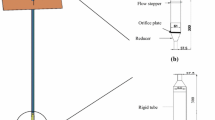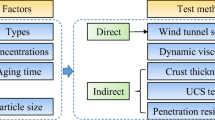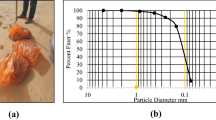Abstract
This study was intended to determine the variation rules of the radon emanation coefficient in dump-leached uranium tailing sand. A temperature and humidity controllable device for measuring the emanation coefficient was designed. Tailing sand with different grain sizes was selected from uranium tailings in southern China. An orthogonal experimental design was conducted to determine the radon emanation coefficient of the sand under different temperatures, humidities and grain sizes. Experimental results showed that the air temperature, humidity and grain size have significant effects on the emanation coefficient. The variation rules regarding the radon emanation coefficient showed significant reference value.



Similar content being viewed by others
References
Tomášek L (1993) Radon exposure and cancers other than lung cancer among uranium miners in West Bohemia. Lancet 341(8805):919–923
Tomášek L, Darby SC, Fearn T (1994) Patterns of lung cancer mortality among uranium miners in West Bohemia with varying rates of exposure to radon and its progeny. Radiat Res 137(2):251–261
Lubin JH, Boice J Jr, Edling C, Hornung RW, Howe GR, Kunz E et al (1995) Lung cancer in radon-exposed miners and estimation of risk from indoor exposure. J Natl Cancer Inst 11(11):817
Darby S, Hill D, Auvinen A, Barrosdios JM, Baysson H, Bochicchio F et al (2005) Radon in homes and risk of lung cancer: collaborative analysis of individual data from 13 european case-control studies. BMJ 330(7485):223–226
Killip IR (2005) Radon hazard and risk in sussex, england and the factors affecting radon levels in dwellings in chalk terrain. Radiat Prot Dosim 113(1):99–107
Krewski D, Lubin JH, Zielinski JM, Alavanja M, Catalan VS, Field RW et al (2005) Residential radon and risk of lung cancer: a combined analysis of 7 north american case-control studies. Epidemiology 16(2):137–145
Yu KN, Lau BMF, Nikezic D (2006) Assessment of environmental radon hazard using human respiratory tract models. J Hazard Mater 132(1):98–110
Denman AR, Rogers S, Ali A, Sinclair J, Phillips PS, Crockett RG et al (2015) Small area mapping of domestic radon, smoking prevalence and lung cancer incidence–a case study in northamptonshire, uk. J Environ Radioact 150:159–169
Pavia M, Bianco A, Pileggi C, Angelillo IF (2003) Meta-analysis of residential exposure to radon gas and lung cancer. Bull World Health Organ 81(10):732–738
NEA, IAEA (2010) Uranium 2009: resources, production and demand. OECD Publishing, Paris
Jobbágy V, Somlai J, Kovács J et al (2009) Dependence of radon emanation of red mud bauxite processing wastes on heat treatment. J Hazard Mater 172(2–3):1258–1263
Kovács T, Shahrokhi A, Sas Z, Vigh T, Somlai J (2016) Radon exhalation study of manganese clay residue and usability in brick production. J Environ Radioact 168:1–6
Sakoda A, Ishimori Y, Hanamoto K, Kataoka T, Kawabe A, Yamaoka K (2010) Experimental and modeling studies of grain size and moisture content effects on radon emanation. Radiat Meas 45(2):204–210
Strong KP, Levins DM (1982) Effect of moisture content on radon emanation from uranium ore and tailings. Health Phys 42(1):27–32
Barton TP, Ziemer PL (1986) The effects of particle size and moisture content on the emanation of rn from coal ash. Health Phys 50(5):581
Markkanen M, Arvela H (1992) Radon emanation from soils. Zhejiang Soc Sci 82(4 Pt 1):2011–2024
Bossew P (2003) The radon emanation power of building materials, soils and rocks. Appl Radiat Isot 59(5–6):389
Breitner D, Arvela H, Hellmuth KH, Renvall T (2010) Effect of moisture content on emanation at different grain size fractions - a pilot study on granitic esker sand sample. J Environ Radioact 101(11):1002–1006
Myers S (1999) Predicting arsenic concentrations in the porewaters of buried uranium mill tailings. Geochim Cosmochim Acta 63(19–20):3379–3394
Lottermoser BG, Ashley PM (2005) Tailings dam seepage at the rehabilitated mary kathleen uranium mine, australia. J Geochem Explor 85(3):119–137
Martin AJ, Crusius J, Mcnee JJ, Yanful EK (2003) The mobility of radium-226 and trace metals in pre-oxidized subaqueous uranium mill tailings. Appl Geochem 18(7):1095–1110
Bassot S, Benitah DSS (2005) Radium behaviour during ferric oxi-hydroxides ageing. Radioprotection 40(Suppl 1):S277–S283
Semkow TM, Parekh PP (2013) The role of radium distribution and porosity in radon emanation from solids. Geophys Res Lett 17(6):837–840
Ishimori Y, Lange K, Martin P, Mayya YS, Phaneuf M (2013) Measurement and calculation of radon releases from NORM residues, Technical reports series No.474. International atomic energy agency. Vienna
Nan H, Ding D, Li G (2014) Vegetation composition and 226Ra uptake by native plant species at a uranium mill tailings impoundment in South China. J Environ Radioact 129(129):100–106
Sui DS, Cui ZS (2009) Application of orthogonal experimental design and Tikhonov regularization method for the identification of parameters in the casting solidification process. Acta Metall Sin (English Letters) 22(1):13–21
Ye YJ, Wang LH, Ding DX, Zhao YL, Fan NB (2014) Inverse method for determining radon diffusion coefficient and free radon production rate of fragmented uranium ore. Radiat Meas 68:1–6
Acknowledgements
This work was supported by National Natural Science Foundation of China (11575080), Hunan Provincial Natural Science Foundation of China (2018JJ2318), the 2017 Graduate Research and Innovation Project Fund (2017YCXXM02) and the 2018 Graduate Research and Innovation Project Fund (2018KYY141).
Author information
Authors and Affiliations
Corresponding author
Ethics declarations
Conflict of interest
The authors declare that they have no competing interests.
Additional information
Publisher's Note
Springer Nature remains neutral with regard to jurisdictional claims in published maps and institutional affiliations.
Rights and permissions
About this article
Cite this article
Huang, Ch., Li, S., Ye, Yj. et al. Variation rules of the radon emanation coefficient in dump-leached uranium tailing sand. J Radioanal Nucl Chem 319, 1037–1043 (2019). https://doi.org/10.1007/s10967-018-06408-2
Received:
Published:
Issue Date:
DOI: https://doi.org/10.1007/s10967-018-06408-2




